Monday Apr 28, 2025
Monday Apr 28, 2025
Wednesday, 20 May 2020 00:30 - - {{hitsCtrl.values.hits}}
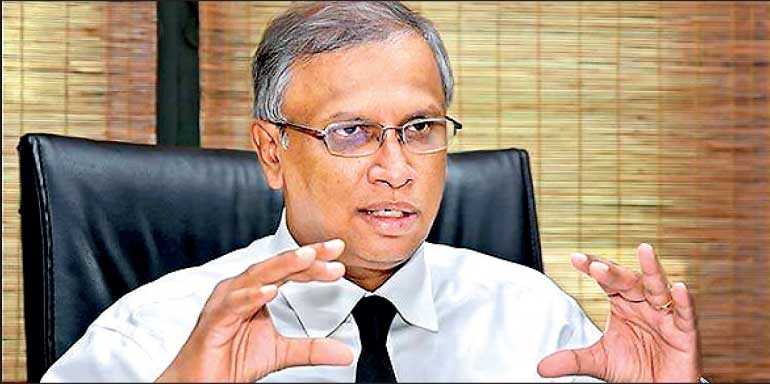
Former Jaffna District Parliamentarian and TNA Spokesperson M.A. Sumanthiran
‘Traitorisation,’ the monster created over the years by Tamil nationalist politics, is running amok again. The current target is former Jaffna District Parliamentarian and Tamil National Alliance (TNA) spokesperson Mathiaparanan Abraham Sumanthiran. 
The lawyer-politician is being attacked as a ‘Tamil traitor’ for some of the comments he reportedly made in a Sinhala language interview conducted by journalist Chamuditha Samarawickrama for his ‘Truth with Chamuditha’ You Tube channel.
A few of the answers in Sinhala were picked up by a Tamil TV aligned to a pro-Government politician and publicised in Tamil. The TV allegedly mistranslated the words of Sumanthiran into Tamil with a mischievous anti-LTTE twist in a bid to irritate and provoke Tigerish and pro-Tiger elements in the Tamil community. It seems to have worked!
The past week or more saw Sumanthiran being attacked viciously by many in a heated exhibition of ‘manufactured rage’ over the mainstream Tamil media and social media within and outside Sri Lanka. A number of media statements were issued by Tamil politicians condemning Sumanthiran.
A common factor in most of the rants and raves was the labelling of Sumanthiran as a Tamil traitor. Effigies of Sumanthiran were displayed with a placard around the neck saying “Naan Our Thamizh Thurogi” (I am a Tamil traitor).
Sumanthiran himself released a 12-minute YouTube video where he gave an ‘explanation’ of what had actually transpired and how his interview in Sinhala was being distorted by interested parties to vilify and attack him. The ex-MP from Jaffna stated that he had responded with restraint to many hostile questions by the interviewer as he wanted to explain some points rationally to a Sinhala audience.
Sumanthiran pointed out that a TV aligned to the ruling regime had taken a few of his comments out of context and publicised them in Tamil in a distorted manner. To his credit Sumanthiran defiantly stood by all that he actually stated in the interview while denying the unfounded accusations of his critics. This YouTube video by Sumanthiran seemed to have turned the tide in his favour as far as sensible people were concerned.
Recurring phenomenon
The targeting of M.A. Sumanthiran as a ‘Tamil traitor’ indicates that the recurring phenomenon of ‘traitorisation’ is occurring again within the sphere of Tamil nationalist politics in Sri Lanka. I have written about this tragic curse afflicting the Tamil people in the past and – given its longevity – I may have to write about it in the future too. It is against this backdrop therefore that I make some specific observations on the traitorisation tragedy in the Tamil polity relying to some extent on my earlier writings.
 |
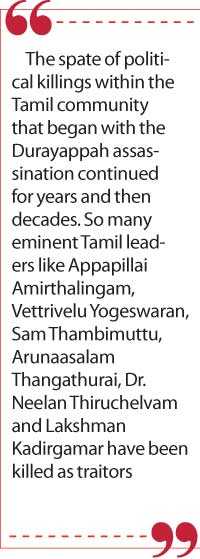 |
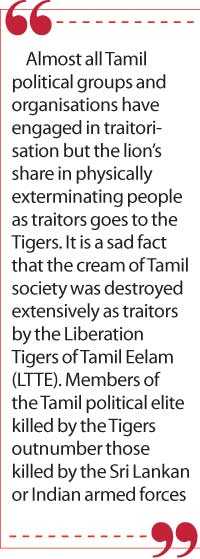 |
 |
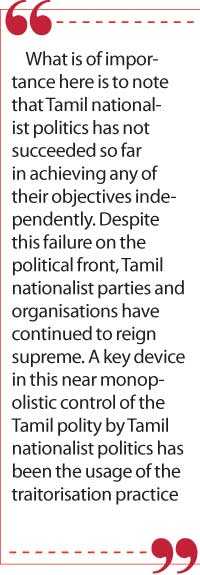 |
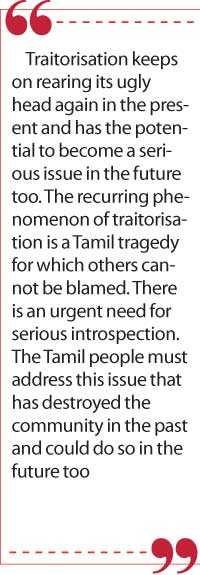 |
I use the word traitorisation instead of treachery or treason in order to differentiate between those who are actually treacherous or really are committing treason as opposed to those being falsely accused or labelled as ‘traitorous’ or traitors. The reality is that most persons dubbed as traitors or ‘thurogigal’ by their political opponents are not ‘guilty’ as charged and do not deserve such a description. ‘Traitorisation’ is a terrible ‘Goebbelsian’ process by which political rivals are falsely portrayed or depicted as traitors.
The ‘traitor’ label in contemporary Tamil political discourse refers generally to Tamils accused of working against the so-called Tamil cause and/or collaborating with the enemy. Concrete proof of such conduct is not necessary. What is required is a massive propaganda effort by which the cry ‘traitor’ is repeated incessantly at multiple levels as advocated by Herr Goebbels in Nazi Germany.
It was Adolf Hitler’s Propaganda Minister Paul Joseph Goebbels who stated: “If you tell a lie big enough and keep repeating it, people will eventually come to believe it.” Repeating the charge ‘traitor’ continuously is the modus operandi of traitorisation in Tamil national politics. Cry ‘traitor’ and let slip the dogs of propaganda war! This Goebbelsian approach is patently visible in the orchestrated attacks on Sumanthiran.
Tamil nationalist politics made use of the Goebbels technique liberally in dubbing those perceived political rivals as traitors. Merely holding a different political view was sufficient to be called traitors to the cause or collaborators with the enemy. The problem was that both the cause and enemy were difficult to define clearly. Moreover, the nature of the cause as well as the identity of enemy underwent changes periodically. Despite these variations, what has remained constant is the practice of traitorisation.
Emphasis on Tamil unity
A key component of traitorisation was the emphasis on Tamil unity. It was argued that Tamils should unite and rally around a single political formation or party. In short, everyone should vote for ‘THE’ party. Other parties cutting into these Tamil votes were engaging in traitorous activity it was alleged. Only candidates from ‘THE’ party should be supported and elected. If not ‘traitors’ from other parties would be elected was the rationale.
When democratic politics gave way to armed militancy, this emphasis on Tamil unity continued. ‘Katchi’ (party) gave way to ‘Iyakkam’ (movement). Only ‘THE’ movement should be supported to demonstrate Tamil unity. Other movements were traitorous. This attitude soon led to skirmishes and then to fratricidal warfare. Youths who thought they were sacrificing their lives at the altar of Tamil Eelam found themselves being butchered as alleged traitors. The same Tamil society which exalted one group of militants as great heroes allowed other groups of militants to be massacred as traitors.
The political violence that destroyed hundreds of alleged traitors in the past was explicitly and implicitly justified by the perpetrators as being necessary to ensure Tamil unity and take forward the struggle for Tamil equality. The tendency was to view all those holding or perceived to be holding different political opinions to that of the dominant one in vogue as being traitors. Dissidence and opinion differences were equated with treachery.
Demonising political adversaries
Arguably the Tamil politician who first promoted the practice of traitorising political rivals or opponents was Ganapathipillai Gangaesar Ponnambalam or G.G. Ponnambalam (Snr).
At the tail-end of the British colonial rule, G.G. Ponnambalam and his party, the All-Ceylon Tamil Congress (ACTC), demanded a scheme of balanced representation popularly known as ‘50-50’. This was unacceptable to the Soulbury Commission which granted a Dominion Constitution.
When elections were held in 1947, G.G. Ponnambalam and the Tamil Congress got the better of Sir. Arunachalam Mahadeva and other UNP Tamil candidates by calling those Tamils who supported the Soulbury Constitution traitors.
After Independence dawned, the pragmatic Ponnambalam changed his stance to ‘responsive cooperation’. He joined the Government and became Industries and Fisheries Minister. Then it became GG’s turn to be called traitor by his erstwhile deputy S.J.V. Chelvanayagam who broke away after the former became a Minister in the D.S. Senanayake Cabinet and founded the Ilankai Thamil Arasuk Katchi (IAK) also known as the Federal Party. The Federal Party (FP) used the traitor label liberally to undermine their rivals.
The practise of demonising political adversaries as traitors took a qualitative turn in the 1970-’77 period. The fiery Tamil poet Kasi Anandan thundered in 1972 that none of the traitorous six Tamil MPs who supported the Republican Constitution of 1972 should die of natural causes.
It also became clear that some Tamil politicians like the popular SLFP Jaffna Mayor Alfred Durayappah would be difficult to defeat politically because of widespread people support. Durayappah was continuously described as traitor in Tamil nationalist discourse. He was portrayed as the cause for all problems affecting Tamils and it was argued that his elimination would usher in a new dawn for the Tamils.
Impressionable young Tamil minds got the message. Durayappah was gunned down in July 1975. Later Prabhakaran was to call it his first “military” operation. None of the Tamil leaders from the FP or Tamil Congress condemned Durayappah’s killing then.
The spate of political killings within the Tamil community that began with the Durayappah assassination continued for years and then decades. So many eminent Tamil leaders like Appapillai Amirthalingam, Vettrivelu Yogeswaran, Sam Thambimuttu, Arunaasalam Thangathurai, Dr. Neelan Thiruchelvam and Lakshman Kadirgamar have been killed as traitors.
Chickens coming home to roost
After President John F. Kennedy was gunned down in Dallas in November 1963, the Black American leader Malcolm X spoke at a ‘Nation of Islam’ meeting in December 1963. When asked about Kennedy’s killing, Malcolm X in his reply seemingly justified it.
He said: “President Kennedy never foresaw that the chickens would come home to roost so soon... Being an old farm boy myself, chickens coming home to roost never did make me sad; they always made me glad.” Malcolm X himself was shot dead two months later in February 1965.
It was a case of the chickens coming home to roost as far as Sri Lankan armed militancy was concerned. The Greek myth about ‘Titan Cronus’ or Saturn feared that he would be overthrown by one of his children. So he devoured the children one by one as they were born. Like Saturn devouring his own children, the Tamil liberation struggle too devoured its own children.
The internecine violence was sought to be justified by the real or imagined existence of traitors. The victims of violence were all traitorised. Later some of the perpetrators themselves were victimised by the violence. The pendulum began swinging the other way and those who traitorised others were in return traitorised.
Vacillating nature of the traitorisation process
Recent history demonstrates the vacillating nature of the traitorisation process where nothing was constant and everything was variable.
In the 1940s of the 20th century, any Tamil not subscribing to ‘50-50 (balanced representation)’ was a traitor. After Independence, any Tamil rejecting Federalism was a traitor. Later on, any Tamil opposing a separate Tamil State became a traitor. Then any Tamil protesting against armed struggle became a traitor. Thereafter all organisations, other than the LTTE were called traitors.
After the LTTE was defeated and the Tamil Eelam demand lost its vigour, the concepts of ‘Thaayagam’ (homeland), ‘Suyanirnayam’ (self-determination) and ‘Thaesiyam’ (nationhood) became the new mantras of contemporary Tamil nationalism. Anyone opposing these three concepts was a traitor.
The absurd logic followed in this traitorisation exercise could be viewed as farcical but for the fact that it gradually assumed a drastic form. When people got killed as traitors, it was no longer a comical exercise. It became tragic. The tragedy in Tamil politics is that this process of traitorisation has led to large-scale killings of politicians, government officials, Police and defence personnel and media personalities as traitors by contending political groups.
Cream of Tamil society destroyed by LTTE as traitors
Almost all Tamil political groups and organisations have engaged in traitorisation but the lion’s share in physically exterminating people as traitors goes to the Tigers. It is a sad fact that the cream of Tamil society was destroyed extensively as traitors by the Liberation Tigers of Tamil Eelam (LTTE). Members of the Tamil political elite killed by the Tigers outnumber those killed by the Sri Lankan or Indian armed forces.
Apart from the moral question as to what right anyone has to dub someone a traitor and kill him or her, there is also the terrible fact that most of those killed as traitors did not fit that description at all. They were mostly people holding different political views from those opposing them. In many instances those projected as traitors were seen as impediments to the progress of others in political terms. Politicians would promise the moon and get votes. They would then give excuses for their inability to deliver by blaming opponents as traitors. It is because of these traitors that we are unable to reach the Promised Land was the lament.
Tamil nationalist politics has failed politically
What is of importance here is to note that Tamil nationalist politics has not succeeded so far in achieving any of their objectives independently. Be it the Tamil Congress, the ITAK, the TULF or the TNA, on the one hand and the Tamil militant groups including the LTTE on the other; they have all failed so far. The solitary gain has been the 13th Constitutional Amendment brought about by the Indo-Lanka Agreement. This would not have been possible without India.
Despite this failure on the political front, Tamil nationalist parties and organisations have continued to reign supreme. A key device in this near monopolistic control of the Tamil polity by Tamil nationalist politics has been the usage of the traitorisation practice. The failure to deliver has been explained away by the excuse of traitorisation. The political stupidity of setting unrealistic unachievable goals is not accepted, instead, the fault is attributed to traitors in our midst. Tamils are told that the fault lies not in ourselves but in our traitors!
There was also a tendency to view mythology and history in a convoluted form. Signs of real or imaginary betrayals were portrayed as the causes for the downfall of those depicted as ‘heroes’ in mythology and history. Ravana the demon king of Lanka who abducted Sita was defeated by her husband Rama, an avatar of Lord Vishnu. The Dravidian ideologues however attribute treachery as the cause because Ravana’s brother Vibheeshana crossed over to Rama’s side.
The feudal ‘Paanchaalankurichi’ chieftain (Polygar) Veera Paandiya Kattabomman defied the British and was vanquished by superior firepower. In popular parlance Kattabomman lost only because another Polygar Ettappa Nayakkar of Ettayapuram joined forces with the British. Betrayals by traitors is assumed as cause of defeat. Thus Ravanan had his Vibeeshanan and Kattabomman his Ettappan in mythology and history. In contemporary Sri Lankan Tamil politics, the list of falsely-accused ‘traitors’ from Mahadeva to Sumanthiran is long and open-ended.
Phenomenon of traitorisation a Tamil tragedy
When the phenomenon of traitorisation began people were not assassinated. They were only character assassinated as traitors. But the rise of armed Tamil militancy in the ’70s of the last century brought about a sea of changes where politicians, officials, civilians and militants got killed as traitors. Mercifully this practice of killing traitors came to an end after the LTTE was militarily defeated and destroyed in the island in May 2009. The traitorisation process, however, remained, but lost much of its potency without the LTTE.
Nevertheless, traitorisation keeps on rearing its ugly head again in the present and has the potential to become a serious issue in the future too. The recurring phenomenon of traitorisation is a Tamil tragedy for which others cannot be blamed. There is an urgent need for serious introspection. The Tamil people must address this issue that has destroyed the community in the past and could do so in the future too.
(D.B.S. Jeyaraj can be reached at [email protected].)
Discover Kapruka, the leading online shopping platform in Sri Lanka, where you can conveniently send Gifts and Flowers to your loved ones for any event including Valentine ’s Day. Explore a wide range of popular Shopping Categories on Kapruka, including Toys, Groceries, Electronics, Birthday Cakes, Fruits, Chocolates, Flower Bouquets, Clothing, Watches, Lingerie, Gift Sets and Jewellery. Also if you’re interested in selling with Kapruka, Partner Central by Kapruka is the best solution to start with. Moreover, through Kapruka Global Shop, you can also enjoy the convenience of purchasing products from renowned platforms like Amazon and eBay and have them delivered to Sri Lanka.
Discover Kapruka, the leading online shopping platform in Sri Lanka, where you can conveniently send Gifts and Flowers to your loved ones for any event including Valentine ’s Day. Explore a wide range of popular Shopping Categories on Kapruka, including Toys, Groceries, Electronics, Birthday Cakes, Fruits, Chocolates, Flower Bouquets, Clothing, Watches, Lingerie, Gift Sets and Jewellery. Also if you’re interested in selling with Kapruka, Partner Central by Kapruka is the best solution to start with. Moreover, through Kapruka Global Shop, you can also enjoy the convenience of purchasing products from renowned platforms like Amazon and eBay and have them delivered to Sri Lanka.